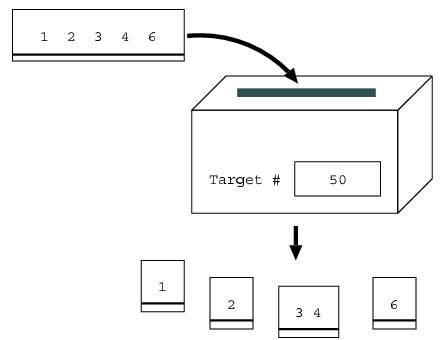
POJ 1416
发布日期:2021-06-30 15:31:14
浏览次数:2
分类:技术文章
本文共 5549 字,大约阅读时间需要 18 分钟。
Shredding Company
| Time Limit: 1000MS | Memory Limit: 10000K | |
| Total Submissions: 6899 | Accepted: 3737 |
Description
You have just been put in charge of developing a new shredder for the Shredding Company Although a "normal" shredder would just shred sheets of paper into little pieces so that the contents would become unreadable, this new shredder needs to have the following unusual basic characteristics.
1.The shredder takes as input a target number and a sheet of paper with a number written on it. 2.It shreds (or cuts) the sheet into pieces each of which has one or more digits on it. 3.The sum of the numbers written on each piece is the closest possible number to the target number, without going over it. For example, suppose that the target number is 50, and the sheet of paper has the number 12346. The shredder would cut the sheet into four pieces, where one piece has 1, another has 2, the third has 34, and the fourth has 6. This is because their sum 43 (= 1 + 2 + 34 + 6) is closest to the target number 50 of all possible combinations without going over 50. For example, a combination where the pieces are 1, 23, 4, and 6 is not valid, because the sum of this combination 34 (= 1 + 23 + 4 + 6) is less than the above combination's 43. The combination of 12, 34, and 6 is not valid either, because the sum 52 (= 12 + 34 + 6) is greater than the target number of 50.
Input
The input consists of several test cases, each on one line, as follows :
tl num1 t2 num2 ... tn numn 0 0 Each test case consists of the following two positive integers, which are separated by one space : (1) the first integer (ti above) is the target number, (2) the second integer (numi above) is the number that is on the paper to be shredded. Neither integers may have a 0 as the first digit, e.g., 123 is allowed but 0123 is not. You may assume that both integers are at most 6 digits in length. A line consisting of two zeros signals the end of the input.Output
For each test case in the input, the corresponding output takes one of the following three types :
sum part1 part2 ... rejected error In the first type, partj and sum have the following meaning : 1.Each partj is a number on one piece of shredded paper. The order of partj corresponds to the order of the original digits on the sheet of paper. 2.sum is the sum of the numbers after being shredded, i.e., sum = part1 + part2 +... Each number should be separated by one space. The message error is printed if it is not possible to make any combination, and rejected if there is more than one possible combination. No extra characters including spaces are allowed at the beginning of each line, nor at the end of each line.Sample Input
50 12346376 144139927438 92743818 33129 314225 1299111 33333103 8621506 11040 0
Sample Output
43 1 2 34 6283 144 139927438 92743818 3 3 12error21 1 2 9 9rejected103 86 2 15 0rejected
Source
今天来不及写了,先马住
// 164K 0MS #include#include int aim;char shred[7];//要切割的数字,做字符串处理 int max_sum;//最大值次数int flag_max;//最大值int shred_sum;//切割次数int ans[7];//最终结果int ans_flag[7];//临时结果保存 void dfs(int x,int num,int y)//这里表示我们从第x 位开始切,当前切得值为num,切的次数为 y{ if(num > aim) return;//寻找不超过目标的最大...那么超过就直接返回 if(x >= strlen(shred))//因为我们从1 开始dfs,那么这里 到刚好 > 的时候就是切出一个答案的时候 { if(num > flag_max)//比我们标记的最大值还大就更新 { max_sum = 1; flag_max = num; for(int q = 0 ; q < y ; q ++)//这里把ans最终结果先更新 ans[q] = ans_flag[q]; shred_sum = y; } else if(num == flag_max) max_sum = 2; } int sum = 0; for(int i = x ; i < strlen(shred); i ++) //我们从当前的x 位置 一个一个尝试 { sum *= 10; sum += shred[i]-'0'; //那么这里就是对于每一次切得到这个值 ans_flag[y] = sum;// 具体的过程,前面有说到的图形解释,后面结合图形有详细说明 dfs(i+1,sum+num,y+1); }} int main(){ int i; int sum1,sum2; while(scanf("%d%s",&aim,shred)) { sum1 = sum2 = 0; if(aim+(shred[0]-'0') == 0) break; max_sum = shred_sum = 0; flag_max = 0; dfs(0,0,0); if(max_sum == 0) printf("error\n"); else if(max_sum > 1) printf("rejected\n"); else { printf("%d",flag_max); for(i = 0 ;i < shred_sum ; i ++) printf(" %d",ans[i]); printf("\n"); } } return 0;}
转载地址:https://joycez.blog.csdn.net/article/details/83420466 如侵犯您的版权,请留言回复原文章的地址,我们会给您删除此文章,给您带来不便请您谅解!
发表评论
最新留言
能坚持,总会有不一样的收获!
[***.219.124.196]2024年05月01日 04时39分35秒
关于作者

喝酒易醉,品茶养心,人生如梦,品茶悟道,何以解忧?唯有杜康!
-- 愿君每日到此一游!
推荐文章
DataURL:实现原理及优缺点分析
2019-05-01
DataURL:实现员工头像保存
2019-05-01
DataURL:员工头像回显
2019-05-01
七牛云存储:通过SDK上传图片
2019-05-01
七牛云存储:断点续传
2019-05-01
七牛云存储:实现员工头像保存
2019-05-01
JasperReport:概述
2019-05-01
JasperReport:声明周期
2019-05-01
Jaspersoft Studio:整合springboot搭建环境
2019-05-01
条件查询分页
2019-05-01
自动填充封装
2019-05-01
修改讲师接口开发
2019-05-01
统一异常处理
2019-05-01
统一日志处理
2019-05-01
vscode安装和使用
2019-05-01
es6的介绍
2019-05-01
es6语法-let定义变量和常量
2019-05-01
解构模板和声明对象
2019-05-01
定义方法简写
2019-05-01
es6语法-对象拓展运算符
2019-05-01